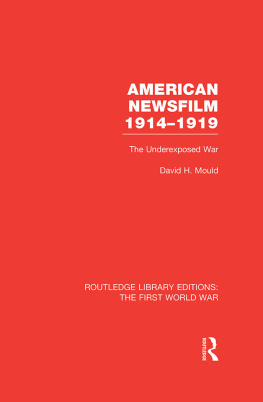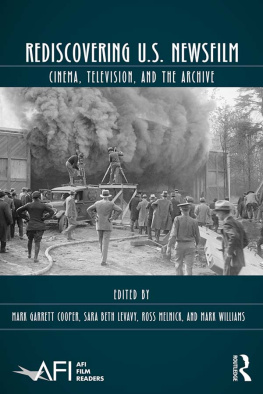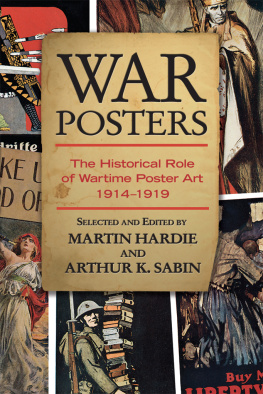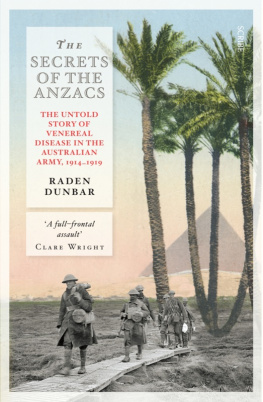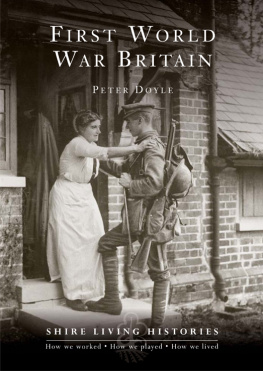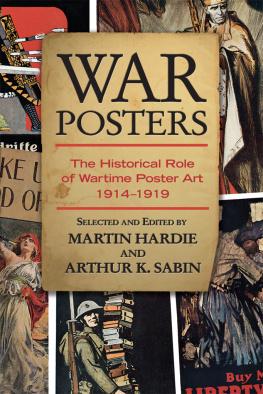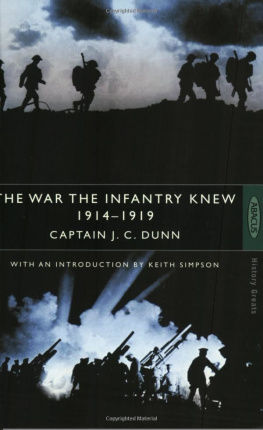ROUTLEDGE LIBRARY EDITIONS: THE FIRST WORLD WAR
Volume 11
AMERICAN NEWSFILM 19141919
AMERICAN NEWSFILM 19141919
The Underexposed War
DAVID H. MOULD
First published in 1983
This edition first published in 2014
by Routledge
2 Park Square, Milton Park, Abingdon, Oxon, OX14 4RN
and by Routledge
711 Third Avenue, New York, NY 10017
Routledge is an imprint of the Taylor & Francis Group, an informa business
1983 David Harley Mould
All rights reserved. No part of this book may be reprinted or reproduced or utilised in any form or by any electronic, mechanical, or other means, now known or hereafter invented, including photocopying and recording, or in any information storage or retrieval system, without permission in writing from the publishers.
Trademark notice: Product or corporate names may be trademarks or registered trademarks, and are used only for identification and explanation without intent to infringe.
British Library Cataloguing in Publication Data
A catalogue record for this book is available from the British Library
ISBN: 978-0-415-74924-4 (Set)
eISBN: 978-1-315-77961-4 (Set)
ISBN: 978-1-138-02223-2 (Volume 11)
eISBN: 978-1-315-77695-8 (Volume 11)
Publishers Note
The publisher has gone to great lengths to ensure the quality of this reprint but points out that some imperfections in the original copies may be apparent.
Disclaimer
The publisher has made every effort to trace copyright holders and would welcome correspondence from those they have been unable to trace.
David H. Mould
AMERICAN NEWSFILM 19141919
The Underexposed War
Garland Publishing, Inc.
New Year & Nondon 1983
Copyright 1983 David Harley Mould
All volumes in this series are printed on acid-free, 250-year-life paper.
Library of Congress Cataloging in Publication Data
Mould, David H. (David Harley), 1949
American newsfilm, 19141919.
(Dissertations on film)
Originally presented as the authors thesis (MA, 1980)
Bibliography: p.
1. World War, 19141918Motion pictures and the war. I. Title. II. Series.
D522.23.M68 1983 791.430909358 81-48349
ISBN 0-8240-5107-6
Design by Jonathan Billing
AMERICAN NEWSFILM, 1914-1919: THE UNDEREXPOSED WAR
by
David H. Mould
This thesis was submitted to the Department of Radio-Television-Film in partial fulfillment of the requirements for the Degree of Master of Arts in June 1980.
My thanks to the following--for their time, ideas, specialized knowledge and encouragement. It made my task a pleasure, instead of a chore!
Charles M. Berg, Radio-TV-Film Department, University of Kansas.
Kevin Brownlow, film historian, London.
Nancy Casey, Sherman Grinberg Film Libraries, New York.
Raymond Fielding, film historian, University of Houston.
Hal Himmelstein, Radio-TV Center, Ohio University.
Garth Jowett, University of Houston.
Bruce Linton, Chairman, Radio-TV-Film Department, University of Kansas.
Linda Loree, John E. Allen, Inc., Park Ridge, New Jersey.
William T. Murphy, Chief, Motion Picture and Sound Recording Branch, National Archives, Washington, D.C.
Calder M. Pickett, School of Journalism, University of Kansas.
Nicholas Pronay, School of History, The University of Leeds.
Emily Sieger, and the staff of the Motion Picture Division of the Library of Congress, Washington, D.C.
Charles Silver, Film Study Center, Museum of Modern Art, New York.
D. H. M.
Lawrence, Kansas Spring, 1980
War is news. It has the quintessential elements of the news story: it affects the lives and welfare of large numbers of people; it involves conflict--between nations, armies and ideals; and it is timely, continually offering fresh developments and perspectives for the journalist. The proximity of the action determines its news value: a civil war at home is more newsworthy than a border dispute on the other side of the world. And the nature of the fighting shapes the coverage: a planned battle between two armies is easier to follow than the hit-and-run actions of guerrilla forces. While the question of whether to cover a war is rarely in doubt, the issues of how to do it--and, in retrospect, how well it was done--are.
These issues will be treated in this study of the first major war to be covered by motion picture photographers--World War I. For the United States, the war had two distinct phases: from August 1914 to April 1917, America was officially a neutral country, although economic, cultural and spiritual ties brought it closer to the Allies than to the Central Powers; after April 1917, the United States was in the war, providing men, money and munitions for the Allies.
These two phases are mirrored in the newsreels and documentary films shown in the United States. In the early years, American cameramen worked on both sides of the lines; if the films showed more of the Allied war effort, it was because these countries produced more footage, and their naval blockade prevented some German films from reaching the United States. After America joined the Allies, most film was shot by Army cameramen, censored by the military authorities in Paris and Washington, and distributed by a government agency, the Committee on Public Information.
When World War I broke out, the American film industry was at a stage of precocious adolescence. More and more films were being produced every year, and there were more and more movie theaters to show them. At the beginning of the war, American motion picture production accounted for more than half the worlds total movie production; by 1917, America was making almost all the worlds motion pictures, as the demands of war took their toll on the film industries of France, Britain, Italy and Germany. For American producers, writes Lewis Jacobs, the European disaster was a stroke of fortune, since it gave them a virtual monopoly of the world movie market. At the same time, the domestic market was expanding; few weeks passed without reports in the trade press of new production ventures, although some were shortlived. A relatively new feature, the newsreel, was growing in favor, and during the war it became an essential part of the standard movie package as support for the main feature. But the young business had developed few professional standards to guide its members.
The industry was singularly ill-prepared to provide comprehensive coverage of a conflict on the scale of World War I. Its development had made it a primarily commercial business: film producers and exhibitors were more concerned with presenting attention-grabbing, heartwarming, tear-jerking subjects than with providing an accurate and balanced account of the war; in the prevailing climate, the faking and restaging of scenes was prevalent, though rarely condoned. Most of the photographers who worked at the front had little or no experience of war coverage; they were hampered by heavy equipment, obstructive military officers, poor communications and over-zealous censors. Even after the United States entered the war, the supply of newsfilm was erratic, censorship capricious and exhibition unashamedly propagandistic.
The study will begin by examining the background to the war for the movie industry--the coverage of previous conflicts and the growth of the newsreel, the main vehicle for the presentation of war footage. The outbreak of war in Europe was the impetus for a flood of war movies--some factual, some fictional--in the United States; the reaction of the industry and audiences to the war will be set against the backdrop of commercial motives and an official policy of neutrality that attempted to set limits on the content of war movies. The experiences of American cameramen who worked in the war zone will be recounted in detail: their efforts to gain access to the front, to overcome problems ranging from unreliable equipment to poor lighting conditions and to evade censorship shaped the coverage of the war. The difficulties in obtaining footage were compounded by the public clamor for war film, and some producers tried to fill the void by faking and restaging scenes; such practices often went unchecked because theater audiences had not developed the critical perception of film we have today.


